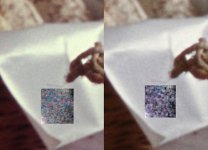What are the problems with SD1? Also planning this route.
XT2 plus good lens is rather too smooth/plastic look. Hardly over 100lpm
Well, for one, you don't get a live preview. This makes it hard to focus, frame, judge the right white balance etc. Further, the camera is quite slow, especially when compared to a modern DSLR like Canon, Nikon, Pentax.
Getting the focus right was my biggest worry, but I am happy to report that the 70mm Macro lens auto-focus is spot on. So that's great.
The speed... you will get used to it. But remember that you will also have to convert the RAW images with Sigma's software, which is another extra step, and that software ain't particularly fast either.
Nevertheless, I think the effort is worth it, if you have the time and patience for it.
I have two 35mm scans online for you to check out:
http://drtebi.com/dump/dslr-scans/paris-las-vegas-sigma-sd-1.jpg
http://drtebi.com/dump/dslr-scans/grand-bar-bordeaux-sigma-sd-1.jpg
The first one was shot with a Konica Hexar AF on Kodak Portra 160 if I remember correctly...
The second one with a Yashica Electro 35 GSN on Fujifilm Provia 100.
Some last thoughts: My goal was to get that Foveon sensor into the mix; since it mimics film, I thought it should be the perfect sensor for scanning film negatives/positives as well. Personally, I like what I am getting a lot. I did a lot of comparisons with a Nikon D800 and Pentax K-1, and I always liked the Foveon look better. Sometimes you need to fight with the reds a bit, they appear to be more accurate with other cameras.
What works best, is taking 4 or 6 images of medium format film and stitch them together... those results are just stunning, to me at least:
http://drtebi.com/dump/dslr-scans/occupied-house-berlin-2x3-dslr-scan-foveon.jpg
http://drtebi.com/dump/dslr-scans/SF-Victorian--Kowa66_Provia100F--Sigma-SD-1M_2x3-stitch.jpg
The first picture was taken with a Plaubel Makina 670 on Fujifilm Provia 100F.
The second picture was taken with a Kowa Six MM and the Kowa 80mm lens on Fuji Provia 100F.
Good luck, and please report your experiences here
🙂



